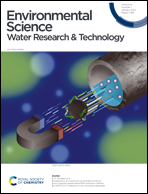Surveillance and seasonal correlation of rotavirus A with coliphages and coliforms in two sewage impacted lakes in highly urbanized regions of western India†
Abstract
Group A rotavirus (RVA), an enteric virus, is a major cause of gastroenteric disease and it is known to cause mortality among children and infants. The applicability of coliforms and coliphages as indicators for RVA was evaluated in this study. The abundance of RVA, ‘SUSP2’, a novel ‘superspreader’ somatic coliphage, MS2, a male-specific coliphage, and coliforms were monitored in two lakes located in the neighboring cities of Mumbai and Thane, India. RVA was detected in 71% and 60% of the composite samples collected from Powai lake in Mumbai and Masunda lake in Thane, respectively. MS2 was detected in 81% and 79%, while SUSP2 was detected in 75% and 81% of the composite samples from Powai lake and Masunda lake, respectively. The maximum RVA, MS2, and SUSP2 concentrations in the composite samples from Powai lake were 5.47 × 105, 6.75 × 102, and 3.47 × 103 copies per 100 mL, respectively, while, the corresponding values for Masunda lake were 2.13 × 104, 2.61 × 104, and 2.21 × 104 copies per 100 mL, respectively. The viral counts were found to be lowest during the monsoon and highest during winter. For samples collected from these lakes, the seasonal correlation between RVA and the indicators was analyzed using Spearman's rank correlation. The coliphages showed a moderate to strong positive correlation with RVA particularly in winter and demonstrated a Spearman correlation coefficient (ρ) in the range of 0.59–0.87 (p < 0.05). However, in the summer and monsoon, a significant correlation between the coliphage, MS2, and RVA was observed only in Powai lake. Thus, coliphages are good indicators of RVA, especially in the winter months, when the occurrence of RVA in the lakes is highest. In the summer and monsoon, both coliphages and coliforms need to be monitored to predict the presence of RVA with a higher degree of confidence. Principal component analysis (PCA) and binary logistic regression (BLR) also confirmed MS2 as a better indicator of RVA. Pearson's correlation coefficient (r) ranged between 0.46–0.74 (p < 0.05). This is the first study reporting the viral load in surface water bodies in India across seasons and the correlation between RVA and coliphages.



 Please wait while we load your content...
Please wait while we load your content...